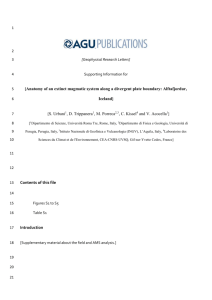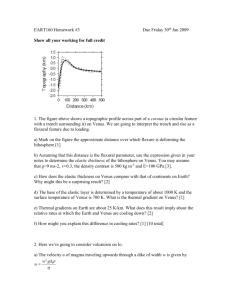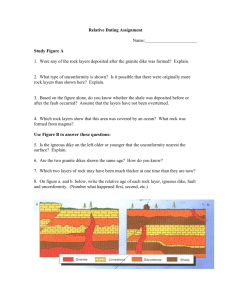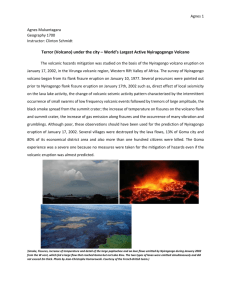ecgsbluebook_july09
advertisement
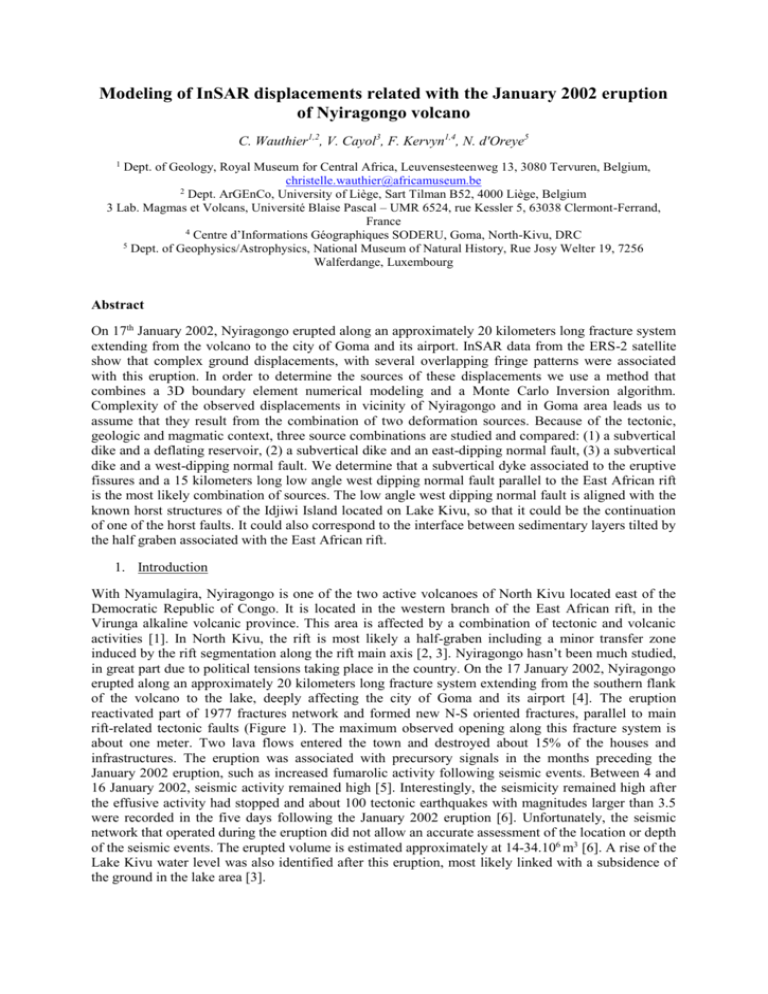
Modeling of InSAR displacements related with the January 2002 eruption of Nyiragongo volcano C. Wauthier1,2, V. Cayol3, F. Kervyn1,4, N. d'Oreye5 1 Dept. of Geology, Royal Museum for Central Africa, Leuvensesteenweg 13, 3080 Tervuren, Belgium, christelle.wauthier@africamuseum.be 2 Dept. ArGEnCo, University of Liège, Sart Tilman B52, 4000 Liège, Belgium 3 Lab. Magmas et Volcans, Université Blaise Pascal – UMR 6524, rue Kessler 5, 63038 Clermont-Ferrand, France 4 Centre d’Informations Géographiques SODERU, Goma, North-Kivu, DRC 5 Dept. of Geophysics/Astrophysics, National Museum of Natural History, Rue Josy Welter 19, 7256 Walferdange, Luxembourg Abstract On 17th January 2002, Nyiragongo erupted along an approximately 20 kilometers long fracture system extending from the volcano to the city of Goma and its airport. InSAR data from the ERS-2 satellite show that complex ground displacements, with several overlapping fringe patterns were associated with this eruption. In order to determine the sources of these displacements we use a method that combines a 3D boundary element numerical modeling and a Monte Carlo Inversion algorithm. Complexity of the observed displacements in vicinity of Nyiragongo and in Goma area leads us to assume that they result from the combination of two deformation sources. Because of the tectonic, geologic and magmatic context, three source combinations are studied and compared: (1) a subvertical dike and a deflating reservoir, (2) a subvertical dike and an east-dipping normal fault, (3) a subvertical dike and a west-dipping normal fault. We determine that a subvertical dyke associated to the eruptive fissures and a 15 kilometers long low angle west dipping normal fault parallel to the East African rift is the most likely combination of sources. The low angle west dipping normal fault is aligned with the known horst structures of the Idjiwi Island located on Lake Kivu, so that it could be the continuation of one of the horst faults. It could also correspond to the interface between sedimentary layers tilted by the half graben associated with the East African rift. 1. Introduction With Nyamulagira, Nyiragongo is one of the two active volcanoes of North Kivu located east of the Democratic Republic of Congo. It is located in the western branch of the East African rift, in the Virunga alkaline volcanic province. This area is affected by a combination of tectonic and volcanic activities [1]. In North Kivu, the rift is most likely a half-graben including a minor transfer zone induced by the rift segmentation along the rift main axis [2, 3]. Nyiragongo hasn’t been much studied, in great part due to political tensions taking place in the country. On the 17 January 2002, Nyiragongo erupted along an approximately 20 kilometers long fracture system extending from the southern flank of the volcano to the lake, deeply affecting the city of Goma and its airport [4]. The eruption reactivated part of 1977 fractures network and formed new N-S oriented fractures, parallel to main rift-related tectonic faults (Figure 1). The maximum observed opening along this fracture system is about one meter. Two lava flows entered the town and destroyed about 15% of the houses and infrastructures. The eruption was associated with precursory signals in the months preceding the January 2002 eruption, such as increased fumarolic activity following seismic events. Between 4 and 16 January 2002, seismic activity remained high [5]. Interestingly, the seismicity remained high after the effusive activity had stopped and about 100 tectonic earthquakes with magnitudes larger than 3.5 were recorded in the five days following the January 2002 eruption [6]. Unfortunately, the seismic network that operated during the eruption did not allow an accurate assessment of the location or depth of the seismic events. The erupted volume is estimated approximately at 14-34.106 m3 [6]. A rise of the Lake Kivu water level was also identified after this eruption, most likely linked with a subsidence of the ground in the lake area [3]. (a) Figure 1. Tectonic setting of Nyiragongo area. (a) Main tectonic and volcanic features of the area. (b) Schematic AA’ profile: the rift is most likely a half-graben with a marked normal fault in the western side but no clear normal bounding fault in the eastern side. The scheme shows possible fault structures in the area. (b) 2. Methods 2.1 InSAR data and processing Displacements associated with 17 January 2002 eruptive event were captured by radar data from the ERS-2 satellite. Combining radar images acquired before and after the event, five independent interferograms were computed, giving displacements along the satellite Line Of Sight (LOS), from the south west of the volcano. In order to obtain large signal to noise data, stable characteristics of the ground surface from a radar acquisition to the next are needed. As the available interferograms have large time spans, characteristics of the ground surface change and the quality (characterized by the coherence of pixels with the surrounding pixels) of interferograms was sometimes low, reducing the number of exploitable interferometric data. The reduced number of available data is also due to the occurrence of Doppler frequencies anomalies in 2001 or too large perpendicular distances (baseline) between acquisitions [7], leading to low signal to noise data. The interferograms were generated with the Doris open-source software [8] using precise orbits from Delft University. The most coherent interferogram, hence in principle the one of highest quality, was selected for further interpretation using numerical modeling and inversions (Figure 2). Because the radar wavelength of the ERS satellite is 5.6 cm, it is sensitive to vegetation, and a loss of coherence is obtained in vegetated areas. In this study, incoherent areas are masked. Studying the available ERS interferograms with a pair-wise logic approach [7], and comparing these data with interferograms captured by the RADARSAT satellite [9], confirms that the observed InSAR signal is actual deformation and not an atmospheric or topographic artefact. The acquisition times of the various interferograms indicate that all the observed ground deformation took place between January 14 and February 13 [10]. Figure 2. ERS-2 Best signal to noise ERS-2 deformation interferogram spanning the January 2002 Nyiragongo eruption: Ascending orbit, Incidence Angle (angle from vertical) = 23°, time span: Sept.00 - July 02, Hamb (Hamb characterizes the sensitivity of the interferogram to errors in the DEM. A DEM error of Hamb would result in a fringe in the interferogram) = 148 m. One color fringe corresponds to 2.8 cm range change in the Line Of Sight direction. The interferogram is wrapped on a Digital Elevation Model [11]. Areas with incoherent interferometric signals have been masked. The signal observed in A corresponds to the compaction of a well-known Nyamulagira lava flows pile (from 1958, 1967, 1980, 1991-93 eruptions). The asymmetric fringes patterns observed in B, C is related to the dyke injection. The subsidence of the Goma area is clearly visible in D with 5 fringes indicating about 14 centimeters of LOS subsidence. The 2002 lava flows are mapped in red. Fractures used for modeling are in green and correspond to observed eruptive fissures. 2.2 Data analysis In order to determine the sources of the observed displacements, we use a method that combines a 3D numerical modeling method and a Monte Carlo inversion method [12]. The numerical modeling method is a mixed boundary element method (MBEM) [13], based on the combination of two boundary element methods: the direct and displacement discontinuity methods. The direct method allows accurate and fast modeling of structures such as a topography, cavities or reservoirs, whereas the displacement discontinuity method is suitable for fractures. The edifice is assumed to be linearly elastic which is supported by theoretical and field studies of dikes [14, 15] and the lack of time dependant deformation associated to the emplacement of dikes. The medium is also assumed to be homogeneous and isotropic, as no other information is available on the mechanical properties of rocks in the Nyiragongo area. The prescribed boundary conditions are tractions; they represent perturbations of an initial state of stress, and are null on the ground and equal to overpressures or shear stress drops on deformation sources [13]. Boundaries (in our case, the ground surface, a dike, a deflating reservoir and normal faults) are meshed by planar triangle elements. The topographic mesh size is ten times larger (200 km in radius) than the deformation sources, so that the limited extension of the ground surface has a negligible influence on the computed displacements [13]. The topographic mesh is dense close to the eruptive fissures and in Goma area where displacement gradients are large and coarse farther away. Displacements created by different sources are compared. Parameters characterizing such sources are shown in Figure 3. Figure 3. For the modeling, the sources and the topography are meshed. Three types of source are studied: (a) A dike connected to the ground via the eruptive fissure. The dike is roughly a quadrangle defined by six geometrical parameters and an overpressure, P0. Three of the geometrical parameters determine the position of the line joining the middle of the top and the bottom part of the quadrangle, i.e., the dip angle (dip), the angle from the maximum gradient (shear), the elevation of the bottom point (botelv). Three other parameters determine the location of the end points of the bottom curve, i.e., the length of the lower curve scaled with respect to the length of the top curve (botlen), the angle of this curve from the horizontal direction (botang), the horizontal angle between the bottom curve and the top curve (twist) (b) A normal fault below the ground. The fault is a quadrangle defined by seven geometrical parameters and a value of shear stress drop, S. (c) A deflating reservoir. The reservoir is a planar ellipsoid defined by height geometrical parameters and a pressure drop, P0. [12, 13] The inversion method used to determine the best-fit model is a near neighborhood inversion algorithm [16]. In order to find the models that best explain the observed data, a misfit function is defined, which quantifies the discrepancy between observed and modeled displacements. It is written as: χ 2 = uo uc Cd1 (uo uc ) T where uo and u c are vectors of observed and modeled line-of-sight (LOS) displacements, respectively, and C d is the covariance matrix. In order to compare modeled displacements with physically meaningful quantities, fringes shown in the interferogram are converted to displacements leading to LOS displacements maps. This procedure, referred as unwrapping, was performed using the SNAPHU open-source software [17]. As the number of data points in an interferogram is too large to be numerically manageable (6142825 pixels), data are subsampled at circular gridded points, in such a way that the number of subsampling points is dense in areas where displacements gradients are large and coarser further away. The unwrapping and subsampling yields to 1147 and 4394 long vectors of observed displacements uo for single (dike) and multiple sources inversions, respectively. The vector of modeled displacements u c is constructed by subsampling modeled LOS displacements at the same points as the observed displacements. The covariance matrix C d is a full matrix which takes the data noise correlation as well as the modeling uncertainties into account. The near neighborhood searches for models that minimize the misfit within predefined model parameter bounds. The algorithm works as follows: n1 (here about 200) initial acceptable models are randomly chosen. Misfits corresponding to the n1 models are then calculated. Next, at each iteration, n new models are generated in the neighborhood of the n lowest misfit models, and misfits for these new models are calculated. Iterations continue until the misfit is not significantly lowered anymore. The neighborhood around a model is defined by a Voronoi cell which covers the area closer to that model than any other model. When n is small, the search is fast but concentrates to a limited model area; when n is large, the search is slow and the search is conducted in a larger model area. Here when inversions are performed for a single source, n is taken to 30, but when multiple sources are inverted for, we can not afford numerically such a large n and thus n is reduced to 10 (Table 1). Single source Number of inverted parameters 6 n (number of new models generated for each iteration) 30 Number of forward models calculated 4273 CPU time (minutes) 62 Table 1. Characteristics of typical inversions Multiple sources 10 10 14893 853 3. Results Before combining numerical models and inversions, MBEM forward models were processed to assess the plausible sources and geometries: a dike associated with the eruptive fissure and west and eastdipping normal faults located in the Goma area. These preliminary tests showed that such sources can fit the InSAR data and that a dike produces displacements similar to those measured only in its vicinity. After this step, a single-source inversion with a dike was performed in order to determine the number of parameters that can be discriminated when inverting data captured from a single LOS direction. In order to invert the interferogram for the dike parameters, only data in the vicinity of the dike were considered. These tests confirmed the presence of a subvertical dike associated with the eruptive fissure. Such a dike fits the data observed on both sides of the eruptive fissure, as shown in Figure 4. This inversion indicates that parameters botlen and twist are close to 1, and 0. Thus, we fix them to these values for the following inversions. This dike is characterized by a low overpressure (0.31 MPa), consistent with the rift context. Such a dike creates 1 meter of maximum opening in the surface, consistent with field observations. The inversion confirmed that this dike does not explain displacements observed further from the eruptive fissure, in the Goma area (D in Figure 2), where there is obviously a superposition of deformation signals related to the various phenomena which occurred during the eruption. As these phenomena occurred at similar times, they probably interacted and thus they have to be simultaneously considered in the models and the inversions. As there were visual observations of an eruptive fissure, a subvertical dike associated with this fissure is always considered in the models. For the simultaneous inversion of two sources, the area considered in the inversion is broader to the west and to the north than for the inversion of a single dike. We investigated three possibilities for the second source: (1) a deflating reservoir, as the Lake Kivu is rich in gas (carbon dioxide, methane…). Indeed, the eruption could have induced a leak in a pre-existing reservoir of planar ellipsoidal shape, as shown in Figure 3. (2) A west or (3) east-dipping normal fault, as such faults are consistent with rift context. The combination of a dyke and an elliptic deflating reservoir poorly fits the data, so we can reject this possibility. Both other possibilities, a dyke and a west or east dipping normal fault, fit the data. The best-fit modeled displacements and the corresponding source geometries are shown in Figure 5 and 6. (a) (b) Figure 4. Results obtained for the single dike inversion: (a) Data, Model and Residuals for the best fit single dike model. (b) Geometry of the best fit single dike. Values of model parameters are given in Table 2. P0 (MPa) 0.31 Dip (°) 92 Botelv (m) -2160 Botlen 1 Twist (°) -1.7 Botang (°) 11 Max. opening (m) 1 V (m3) 5e+07 Rms (mm) 8.5 Table 2. Characteristics of best fit single dike model showed in Figure 4. Shear is fixed to 0°. Rms stands for root mean squared error. (a) (b) Figure 5. Results obtained for the simultaneous dike and east-dipping fault inversion: (a) Data, Model and Residuals for the best fit model. (b) Geometry of the best fit dike and fault. Values of model parameters are given in Table 3. (a) (b) Figure 6. Results obtained for the simultaneous dike and west-dipping fault inversion: (a) Data, Model and Residuals for the best fit model. (b) Geometry of the best fit dike and fault. Values of model parameters are given in Table 3. A 2.5 to 3 kilometer high subvertical dyke and a 16 km long narrow east-dipping normal fault extending from the south flank of Nyiragongo to the northern part of lake Kivu fits the data in the Goma area well (rms is 15 mm). However, the interaction between these two sources is mechanically inconsistent, as the fault displacement induces closure of the dyke. A 1.5 to 2 kilometer high subvertical dyke and a 15 km low angle (25°) west-dipping normal fault extending from the south flank of Nyiragongo to the northern part of lake Kivu fits the data equally well (rms is also 15 mm) but it is a more likely combination of sources, as the opening of the dike is consistent with the fault motion. The dike is submitted to a low overpressure of 0.15 MPa, which is consistent with the rift context. Such a dike creates 0.4 meter of maximum opening in the surface, consistent with field observations. The fault is associated to a low stress drop, but this value is in the range of plausible values for normal faults [18]. The corresponding moment magnitude is 4.9, which is consistent with the magnitude of events observed around Lake Kivu during the period covered by the interferograms, where about 24 events with magnitudes larger than 4, and four events with magnitudes larger than 5 were observed. Modeled displacements induce about 13 cm of maximum LOS subsidence of the lake shore consistent with the observation. The fault is roughly aligned with one of the Idjiwi Island normal faults, a horst structure visible 50 kilometers south on Lake Kivu (see Figure 1). Thus it could be in the continuation on one of the horst normal faults. The low angle of the fault, which is unusual for a normal fault, is consistent with the tilting of sedimentary layers caused by the asymmetrical opening of the rift. Faulting could results from the reactivation of the contact between tilted lithological (sedimentary and/or volcanic) layers. The model needs to be improved as data from only one LOS were used. In order to improve the measurement of the co-eruptive displacements, more acquisitions geometries are needed such as those provided by the RADARSAT-1 images. The western part of the study area (E area in Figure 2) can only be explained by the introduction of a third source. Preliminary models showed that a simple deflating spherical source, west of Nyamulagira volcano, can explain this signal. However, the inversion predicts a 24 kilometer deep source. This disagrees with the depth inferred from geophysical and petrological data which suggested that the magmatic chamber of Nyamulagira is located between 3 and 7 kilometers depth [19, 20]. We are currently exploring other possible sources such as another normal fault in the vicinity of the two neighboring volcanoes. (1) (2) P0 (MPa) Dip (°) Botelv (m) Botang (°) Max. op. (m) V (e+06m3) Midx, Midy (km) Midz (m) Toplength (km) Height (m) Strike (°) Dipf (°) S (MPa) Mw Rms (mm) 0.24 0.14 70 90 -1000 69 3.6 0 0.9 0.4 32 6 747, 9820 748, 9820 -2300 0 18.6 15,6 970 3200 21 22 60 25 3 0.2 5.8 4.9 15 15 Table 3. Characteristics of best fit dike and east-dipping fault model (1) and dike and west-dipping fault (2) showed in Figures 5 and 6 respectively. 10 parameters were inverted for both inversions. For the dike, in both inversions: Shear is fixed to 0°, Botlen fixed to 1, and Twist fixed to 0°. Other fixed parameters are underlined. Mb is the body-wave magnitude. 4. Conclusions We determine that the main part of deformation signal observed by InSAR South and East of Nyiragongo between 14 January and 13 February 2002 can be explained by the combined effects of a 2 km high subvertical dike feeding the observed eruptive fissure, and a 15 km long west dipping normal fault extending from the foot of Nyiragongo to the northern part of lake Kivu. The dike is submitted to a low overpressure of 0.14 MPa, consistent wit the rift extension. This fault is in the continuation of the known horst structures of the Idjiwi Island. It could also correspond to the interface between sedimentary layers tilted by the half rift graben opening. The model has to be refined, first, by taking into account the other InSAR data (RADARSAT data) available for this eruption and then by modeling the western part of the InSAR signal possibly associated to a deflating magmatic reservoir or a deep normal fault. 5. References [1] Ebinger C.J and Furman T., Geodynamical setting of the Virunga volcanic province, East Africa, In : Acta Vulcanologica, The January 2002 eruption of Nyiragongo volcano and the socio-economical impact, Vol. 14 (1-2) et vol. 15 (1-2), Istituti editorali e poligrafici internazionali, Pisa-Roma, 9-16, 2004. [2] Corti G., Bonini M., Innocenti F., Manetti P., Mulugeta G., Sokoutis D., and Cloetingh S., Rift-parallel magma migration and localisation of magmatic activity in transfert zones, In : Acta Vulcanologica, The January 2002 eruption of Nyiragongo volcano and the socio-economical impact, Vol. 14 (1-2) et vol. 15 (1-2), Istituti editorali e poligrafici internazionali, PisaRoma, 17-26, 2004. [3] Wauthier C., Modélisation des déplacements InSAR survenus au Nyiragongo en janvier 2002, Mémoire de Master 2 recherche, Université de Clermont-Ferrand II, 52p. , 2007. [4] Komorowski J-C, Tedesco D., Kasereka M., Allard P., Papale P., Vaselli O., Baxter P., Halbwachs M., Akumbe M., Baluku B., Briole P., Ciraba M., Dupin J-C, Etoy O., Garcin D., Hamaguchi H., Houli´e N., Kavotha K.S., Lemarchand A., Lockwood J., Lukaya N., Mavonga G., De Michele M., Mpore S., Mukambilwa K., Munyololo F., Newhall C., Ruch J., Yalire M. and Wafula M., The January 2002 flank eruption of Nyiragongo volcano (Democratic Republic of Congo) : Chronology, evidence for a tectonic rift trigger, and impact of lava flows on the city of Goma, In : Acta Vulcanologica, The January 2002 eruption of Nyiragongo volcano and the socio-economical impact, Vol. 14 (1-2) et vol. 15 (1-2), Istituti editorali e poligrafici internazionali, Pisa-Roma, 27-62, 2004. [5] Allard P., Baxter P., Halbwachs M., and J.-C. Komorowski, The January 2002 eruption of Nyiragongo volcano (Dem. Repub. Congo) and related hazards: observations and recommendations, Final Report of the Franc-British scientific team, Paris, March 8, 2002. [6] D. Tedesco, O. Vaselli, P. Papale, S. A. Carn, M. Voltaggio, G. M. Sawyer, et al., “January 2002 volcano-tectonic eruption of Nyiragongo volcano, Democratic Republic of Congo”, J. Geophys. Res., 112, B09202, doi:10.1029/2006JB004762, 2007. [7] Massonet D. and Feigl K.L., 1998, Radar interferometry and its application to changes in the Earth’s surface, Reviews of Geophysics, 36(4), 441-500. [8] B. Kampes and S. Usai, “Doris: The Delft Object-oriented Radar Interferometric software,” Proc. ITC 2nd ORS symposium, August 1999, The Netherlands, 1999. [9] M. Poland, “InSAR Captures Rifting and Volcanism in East Africa,” Alaska Satellite Facility News & Notes, Vol. 3:2, 2006. [10] C. Wauthier, V. Cayol, N. D’Oreye and F. Kervyn, “Modeling of InSAR displacements related with the January 2002 eruption of Nyiragongo volcano (DRC),” Proc. of 4th ESA Fringe2007 workshop, ESA-ESRIN, Frascati, Italie, 26-30 November 2007. [11] Farr, T. G., et al., 2007, The Shuttle Radar Topography Mission, doi:10.1029/2005RG000183. Rev. Geophys., 45, RG2004, [12] Y. Fukushima, V. Cayol, and P.Durand, “Finding realistic dike models from interferometric synthetic aperture radar data: The February 2000 eruption at Piton de la Fournaise,” Journal Geoph. Res., VOL. 110, B03206, 2005. [13] V. Cayol, and F.H. Cornet, “3D mixed boundary elements for elastostatic deformations fields analysis”, Int. J. Rock Mech. Min. Sci. Geomech. Abstr., 34, 275-287, 1997. [14] P. T. Delaney, D. D. Pollard and J. I. Ziony and E. H. McKee, Field relations between dikes and joints: Emplacement processes and paleostress analysis, J. Geophys. Res., 91, 4920-4938, 1986. [15] A. M. Rubin, Propagation of magma-filled cracks, Annu. Rev. Earth Planet. Sci., 23, 287-336, 1995. [16] M. Sambridge, 1999a, Geophysical inversion with a neighbourhood algorithm - I. Searching a parameter space, Geophys. J. Int., 138, 479-494. [17] Chen C.W. and H.A. Zebker, 2001, Two-dimensional phase unwrapping with use of statistical models for cost functions in nonlinear optimization, Journal of the Optical Society of America, A, vol. 18, 338-351. [18] Allmann, B. and P. M. Shearer, 2009, Global variations of stress drop for moderate to large earthquakes, J. Geophys. Res., 114, B01310, doi:10.1029/2008JB005821. [19] Hamaguchi H., 1983, Seismological evidence for magma intrusion during the 1981-1982 Nyamuragira eruption, In : Hamaguchi H. (ed.), Volcanoes Nyiragongo and Nyamuragira : Geophysical aspects, Tohoku University, Sendai, Japon, 2933. [20] Mishina M., 1983, Gravity survey in and around Volcanoes Nyamuragira and Nyiragongo, In : Hamaguchi H. (ed.), Volcanoes Nyiragongo and Nyamuragira : Geophysical aspects, Tohoku University, Sendai, Japon, 69-74.
